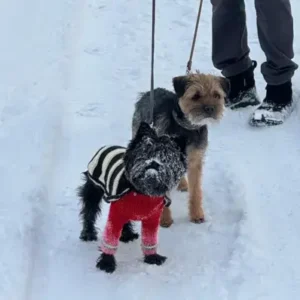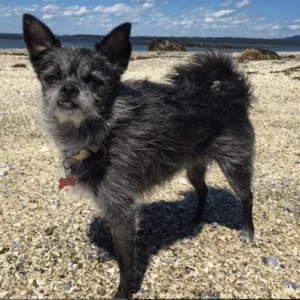Shetland Sheepdog History/Origin
Shetland Sheepdogs, or Shelties, were initially bred in the rugged Shetland Islands, the northernmost point of the United Kingdom. Farmers relied on them to herd sheep, ponies, and poultry. An old slang term for Shelties is “Toonie dog,” with “toon” being a Shetland word for farm.
The Sheltie was intentionally bred to be smaller than its close relative, the rough-coat Collie. This compact size means Shelties require less food than larger herding breeds, a vital factor in the cold, harsh climate of their homeland, where food resources can be limited. This smaller stature also explains the size of Shetland ponies.
Shetland Sheepdog History- Source: AKC.org
The exact timeline of when Collies were brought to the islands from the Scottish mainland and bred down to Sheltie size remains unclear, as breeders left no written records. Due to the islands’ isolation, Shelties were virtually unknown outside the region until the early 20th century.
The Shetland Sheepdog is a fantastic herding dog that shares some traits with the Border Collie, as both are intelligent and energetic breeds developed for managing livestock.
These purebred dogs were first recognized by the Kennel Club (England) as the Shetland Collie in 1909. However, due to pressure from Collie enthusiasts, the name was soon changed to Shetland Sheepdog. The American Kennel Club registered its first Sheltie under Herding Group in 1911, showcasing this remarkably intelligent and obedient breed.
Shetland Sheepdog Personality
The Shetland Sheepdog, or Sheltie, is one of the dog breeds known for its intense love and loyalty toward family members. While they may not be particularly fond of strangers, Shelties are incredibly devoted to their loved ones.
- Shetland Sheepdog Temperament
One of their most endearing traits is their exuberant excitement—they often express this by barking enthusiastically and spinning around in circles, especially when they see another dog.
- Potential Challenges
Shelties are known for being more vocal than many other breeds, which can lead to excessive barking if not managed properly. Their herding instinct also manifests in a tendency to nip at objects and, unfortunately, children, especially when they’re feeling playful or excited.
While these behaviors can be challenging, Sheltie’s high intelligence and eagerness to learn mean that early training is crucial. With consistent guidance and socialization, many of these less desirable traits can be effectively addressed, allowing for a harmonious relationship with both family members and guests.
Shetland Sheepdog Physical Appearance
Many Shelties resemble smaller versions of Rough Collies. They have a long body but a short stature. Sporting a double coat, the Sheltie features a fluffy mane around its upper chest and neck. The fur on their head, ears, and feet is long and straight, while the mane is fringed and abundant.
Their legs and tail also have long, furry hair. The Shetland Sheepdogs, often referred to as miniature collies, are intelligent and agile working dogs known for their herding abilities and loyalty to their families.
- Shetland Sheepdog Size
The Shetland Sheepdog typically measures between 13 and 16 inches in height at the shoulder, although it’s not uncommon to find individuals that are either slightly larger or smaller than this range. On average, a healthy Sheltie weighs around 22 pounds.
- Coat color
Shelties are distinguished by their double coat, featuring a short, dense undercoat that supports a longer, harsher topcoat, giving them a distinctive appearance. The hair on their head, ears, and feet is smooth, while their mane and frill—found around the neck and forechest—are quite abundant.
Additionally, their legs and tail are covered in fluffy fur. The breed showcases three primary colors, each with varying amounts of white and/or tan markings: sable, which ranges from golden to mahogany; black; and blue merle, characterized by a striking blue-gray hue interspersed with black.
Shetland Sheepdog Gender Differences
The primary differences between male and female Shetland Sheepdogs are hormonally driven. Unspayed females will go into heat, while unneutered males often display marking behaviors. Males are also more likely to wander, especially if they detect a female in heat.
However, if you choose to spay or neuter your Sheltie, these differences become less noticeable. With the hormonal variations minimized, any personality differences between the sexes become significantly less apparent.
Shetland Sheepdog Feed/Nutrition
Feeding your adult Shetland Sheepdog requires careful consideration of several factors, including their size, age, build, metabolism, and activity level. Typically, they should receive between 3/4 to 2 cups of high-quality dog food each day, divided into two meals.
It’s important to remember that, much like people, dogs are individuals, and their dietary needs can vary significantly. An active Sheltie will require more food than a less active one. Including healthy vegetables like broccoli in their diet can offer added nutrients, but be sure to feed them in moderation and avoid seasoning.
Additionally, the quality of the dog food plays a crucial role in your dog’s nutrition—higher quality food will be more effective in meeting their dietary needs. To help maintain your Sheltie’s health, it’s best to measure their food and establish a routine of feeding them twice a day, rather than leaving food out all the time.
Shetland Sheepdog Health Issues
Shelties are generally healthy, but like all breeds, they’re prone to certain health conditions. Not all Shelties will develop any or all of these diseases, but it’s important to be aware of them if you’re considering this breed.
- Hypothyroidism: This condition arises when the body cannot maintain adequate levels of thyroid hormones, leading to weight gain, a thinning coat, and sensitivity to cold. If you notice these signs, consult your vet, as hypothyroidism is manageable with daily medication for life. Checking the thyroid status of your puppy’s grandparents can provide insights into potential risks.
- Collie Eye Anomaly: CEA is an inherited condition that can lead to blindness, typically diagnosed by two years of age. While the severity varies, many dogs with minor anomalies maintain good vision, and spaying or neutering is recommended to prevent passing the genetic defect to future generations.
- Von Willebrand Disease: This inherited blood disorder results from a deficiency in clotting factor VIII, leading to excessive bleeding after injuries or surgeries. Most dogs live normal lives despite this condition, but if you suspect a risk, your vet can perform tests to confirm whether your dog has it.
- Hip Dysplasia: In this condition, the femur does not fit snugly into the pelvic socket of the hip joint, leading to potential pain or lameness. Consult your vet if you notice symptoms, as screening through the Orthopedic Foundation for Animals (OFA) or the University of Pennsylvania Hip Improvement Program (PennHIP) can provide clarity and management options.
- Dermatomyositis: This inherited disorder causes skin lesions and may affect muscles, primarily in Collies and Shetland Sheepdogs. Signs include lesions on the head and legs, and diagnosis is made through a skin biopsy. Currently, no direct test exists for this condition, so understanding its hereditary nature is essential.
Shetland Sheepdog Care and Grooming
Although Shelties were bred to endure harsh weather, they thrive indoors with their families, loving to be part of the household. While they can be calm inside, Shelties are energetic farm dogs at heart and need plenty of exercise. They enjoy walks, fetch, and even zipping around the house, but afterward, they’re happy to cuddle up on the couch.
Despite their small size, Shelties can adapt to apartment living if their owners commit to daily exercise, playtime, and training, especially to manage barking. Shelties are sensitive, so positive reinforcement works best. Rather than scolding for barking, acknowledge their alertness and gently correct any excessive behavior.
Shelties need weekly grooming, especially during shedding season. Their thick double coat requires brushing with a mist of water to avoid damage, with extra care taken behind the ears.
Males and spayed females typically shed once a year, while unspayed females shed twice a year. Baths are necessary only when they’re truly dirty, as their coats repel dirt and water naturally.
Regular nail trims, ear checks, and dental care are essential, and starting these habits early helps your Sheltie get comfortable with grooming. Additionally, training your dog to sit is a valuable command that can make grooming sessions easier and more enjoyable for both of you.
Shetland Sheepdog Rescue Groups
If you’re considering adding a Sheltie to your family, adopting from a rescue organization is a wonderful option. Many Shelties in need of homes are waiting at breed-specific rescues or general dog shelters. By rescuing, you give a Sheltie a second chance while supporting the importance of adoption.
Shetland Sheepdog Price
The price of a Shetland Sheepdog typically ranges from $800 to $2,000, depending on factors such as breeder reputation, pedigree, and location.
If you’re looking to purchase a Sheltie, be sure to seek out reputable breeders who prioritize health, temperament, and proper care. A responsible breeder will provide health clearances for the parents and ensure that puppies are raised in a loving environment.
Interesting Facts
- The Shetland Sheepdog gets its name from its origins in the Shetland Islands of Scotland, where the breed was first developed.
- Shetland Sheepdog played a role in the popular animated series “The Jetsons” as the character Astro’s breed.
The Jetsons- Source: IMDb
- Shetland Sheepdogs are a beloved breed that usually ranks in the top 30 of the most popular dog breeds registered by the AKC.
- They have appeared in the Breed Judging Show 2024.
Best For
Shetland Sheepdogs are ideal pets for individuals or families who can provide them with plenty of exercise, mental stimulation, and affectionate companionship. Their loving nature makes them great for those who appreciate a loyal, interactive pet, while their intelligence allows for easy training and engagement in various activities. However, potential owners should be prepared for regular grooming and be committed to positive reinforcement training methods.
Top Names
| Male Sheltie Names | Female Sheltie Names |
| Max | Bella |
| Finn | Daisy |
| Charlie | Luna |
| Cooper | Molly |
| Teddy | Zoey |









 Shetland Sheepdog History- Source:
Shetland Sheepdog History- Source: 

 Sable Shetland Sheepdog- Source:
Sable Shetland Sheepdog- Source:  Blue Merle Shetland Sheepdog- Source:
Blue Merle Shetland Sheepdog- Source:  Tricolor Shetland Sheepdog- Source:
Tricolor Shetland Sheepdog- Source: 
 The Jetsons- Source:
The Jetsons- Source: 






